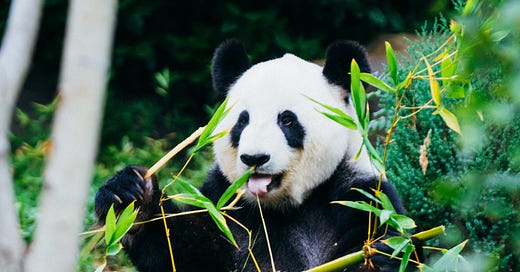China Animal Welfare Translations No. 3 - November 2021
Zoos, wildlife protection, China Zoo Ethics and Animal Welfare Convention
It’s been a while, but here it finally is: the 3rd edition of the China Animal Welfare Translations Newsletter! If you do not yet know what that is, check out the “About” section on the website!
While the first two editions were mostly about farmed animals, this time we will look at some nice texts regarding the welfare of zoo animals in China! As always, I am very happy to hear your thoughts on the usefulness of these different topics. Simply send a short informal message by email or fill in this form! This newsletter is in a very early stage, so your feedback can help me a lot to make sure that the content is tailored to the needs and interests of my readers!
You can subscribe to the newsletter here and browse through an archive of all past editions.
1. Translation: Animal Farm - Zoos In The Era Of Monopoly Capital
Some background:
This article has been published on WeChat by a semi-academic channel called “TyingKnots” which tries to introduce anthropological perspectives on a wide range of social and cultural issues in China and beyond. They recently featured a series of articles dedicated to animal welfare.
The article discusses how the welfare of zoo animals in China is intertwined with profit-making in increasingly complex industrial chains: “The problems are definitely no longer ‘simple’. If we do not recognize this, we can overlook that in the era of monopoly capital, a zoo is not just a space for humans and animals to meet, it is also the end point of illegal poaching and the starting point of animal products.”
There are a total of four case studies on tragic events in Chinese zoos in the article, two of which are translated here.
What happened in these two tragic events?
In February 2010, 11 Siberian tigers died from hunger in the Shenyang Forest Wildlife Park. How could that happen? Zoo employees went on a strike due to long-term back pay and refused to feed the animals until they received their salary.
In April this year, three tigers escaped from the zoo in Hangzhou, the capital of Zhejiang province. The zoo tried to cover up the escape out of fear that the incident would reduce visitor numbers on the May 1 holiday. Once uncovered, the story quickly made headlines all over China.
Fun fact: even until today, only two of the three escaped tigers have been found.
Read the full translation to get more details and an excellent contextualization of these stories!
My 2 cents:
The case from Shenyang Forest Wildlife Park highlights the connection between animal welfare and employee well-being in an unusually direct and vivid way. The importance of organizational culture, employee management, and good working conditions for animal welfare has been analyzed in the context of farmed animals in this recent article.
The article also offers concrete evidence for how an economic agenda can hamper animal welfare work. This is also reflective of China’s Wildlife Protection Law which one Chinese animal protection advocate cynically described like this: “This law is widely known by animal protection people in China as a law of how to use animals rather than how to protect animals.” (more on the legal context in the 2nd translation below)
A small detail worth noticing: The National Forestry and Grasslands Administration dispatched an investigation team and was able initiate as radical steps as re-nationalization of the zoo. This demonstrates that, once the problem became apparent, the enforcement capability of the relevant government authority was actually quite high!
One caveat: it is often unclear what exactly the “relevant government authority” is since animal welfare is not formally assigned to any specific ministry in China. Instead, responsibility is dispersed over the Ministry of Agriculture, the National Forestry and Grasslands Administration, and the Ministry of Housing and Urban-Rural-Development.
2. Translation: China Zoo Ethics and Animal Welfare Convention
Some background:
This short convention was published in 2012 by the Chinese Association of Zoological Garden (中国动物园协会), the official trade association affiliated with the Ministry of Housing and Urban-Rural Development (remember: that is one of the ministries responsible for animal welfare in China).
My 2 cents:
Don’t get too excited: This document is purely aspirational and does not have any direct legal enforcement mechanism attached to it.
Do get a little bit excited though: In 2017, the Ministry of Housing and Urban-Rural-Development itself enacted the Zoo Management Regulations (动物园管理规范). This is a much more concrete policy document that also outlines all the technical details for zoo management, such as “design of animal shelter, hospital, incubation room, food, storage, etc”.
The cool thing is: it also includes the key principles on animal welfare from China Zoo Ethics and Animal Welfare Convention! So even fuzzy inspirational words can slowly make their way into more concrete legislation.
Pssst! I may translate the Zoo Management Regulations in a future edition of this newsletter, let me know if you think it could be useful or not!
Notions of “animal welfare” and “species conservationism” are conceptually merged into one single idea of “animal protection” in this convention.
Even though this is somewhat problematic, the fact that the Chinese government is supportive of conservationism might also imply an opportunity for indirectly improving wild animal welfare through species conservation work.
Remember: This document really only concerns zoo animals specifically.
What to look for next: The Chinese Veterinary Medical Association (中国兽医协会) has drafted general guidelines on animal welfare for all kinds of categories of animals. These have already been approved by the National Animal Husbandry Standardization Technical Committee in 2017, but are still waiting for approval by the Ministry of Agriculture.
I would like to thank Isla who translated parts of the first document!




